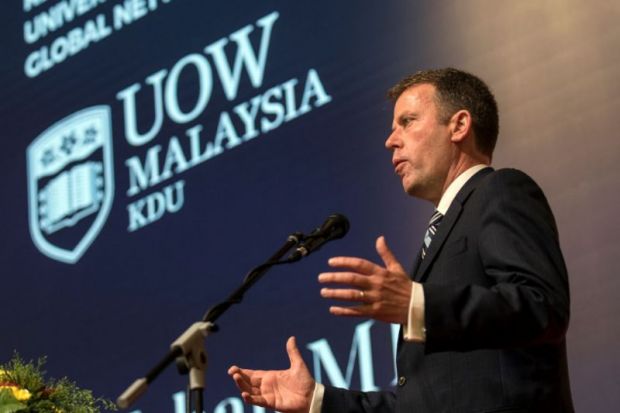An Australian university is confident that its Malaysian outposts will thrive, notwithstanding the fiscal snags that have afflicted other offshore adventures.
A Kuala Lumpur inauguration ceremony has marked the transition of several campuses of KDU, a Malaysian private higher education provider, into the University of Wollongong ‘Global Network’. When a fourth campus opens early next year at Batu Kawan, near Penang Island, the partnership expects to have 7,500 enrolments.
UOW’s majority purchase of KDU, announced a year ago, gives the university an overseas presence to complement its operations in Dubai and Hong Kong – both noted education hubs, senior deputy vice-chancellor Joe Chicharo acknowledged.
“If you look at where Wollongong has located offshore, it is precisely where the competition is,” he said. “Maybe we’re crazy that we’re in these competitive environments. When you look at universities that deliver education offshore, there are a lot of train wrecks out there.”
But Professor Chicharo said that Wollongong had consciously chosen crowded markets to test itself. “It is about proving to ourselves that the programmes we offer in Australia are competitive and relevant in other parts of the world,” he told Times Higher Education. “We’re not shying away from competition.”
Wollongong is one of just four Australian universities with more international students in their offshore campuses than back at home, the ceremony heard. In a sector increasingly bankrolled by tuition fees from overseas visitors, branch campuses have a reputation as money pits.
“There’s not a pot of gold in these offshore operations,” Professor Chicharo conceded. “It’s not driven by a huge profit line. It is about diversifying your international education. We have students that come here, but also students who go from here to Australia. We see that as a very important ecosystem.”
Australian education minister Dan Tehan, in Malaysia for his first overseas visit in the role, said that offshore students comprised almost one-quarter of Australia’s international enrolments. “One of the things that not many people in Australia know is that a lot of our overseas education is about our universities investing in other countries,” he said.
He urged students attending the ceremony to seize the chance to do parts of their studies in Hong Kong, Dubai or Australia: “What a wonderful opportunity in a globalised world.”
Siti Hamisah, director-general of Malaysia’s higher education ministry, said Wollongong’s arrival brought the tally of foreign university branch campuses in her country to 11.
Dr Siti said that while Malaysia was “steadily gaining recognition” for a higher education system with a 46 per cent youth participation rate, it was still battling many challenges. She hoped that Wollongong’s presence would “add values” to local teaching and research capabilities as well as boost the country’s appeal as an education destination.
A perception that Malaysia was saturated with foreign outposts led to a moratorium on new branch campuses in 2012. UOW Global Enterprises chief executive Marisa Mastroianni said Wollongong had sidestepped that restriction by acquiring an established college.
But she said that “extensive researching work”, coupled with Wollongong’s experience delivering education in Malaysia through a “franchising model”, had convinced the university that there was demand for its courses. “We were very clear that we had something of value to bring into the market,” Ms Mastroianni said. “The top end isn’t as crowded as you’d think, and the top end is where we will be.”
Register to continue
Why register?
- Registration is free and only takes a moment
- Once registered, you can read 3 articles a month
- Sign up for our newsletter
Subscribe
Or subscribe for unlimited access to:
- Unlimited access to news, views, insights & reviews
- Digital editions
- Digital access to THE’s university and college rankings analysis
Already registered or a current subscriber? Login









